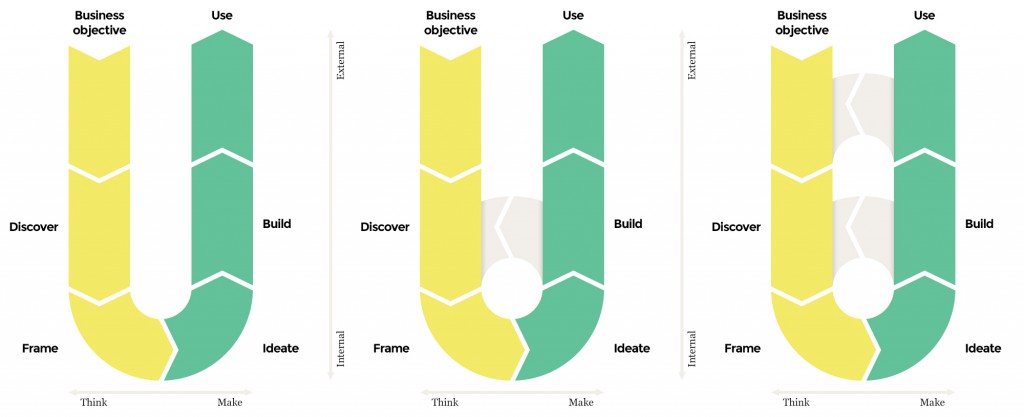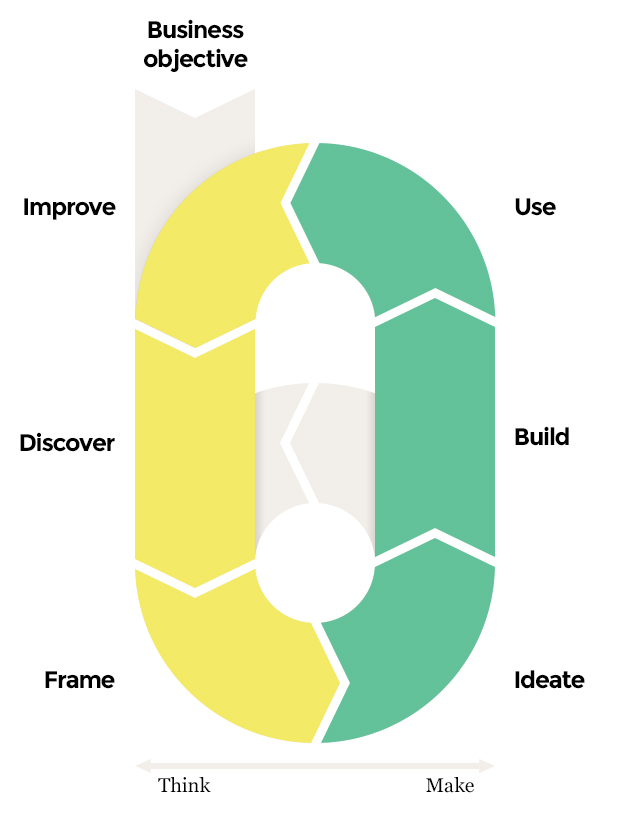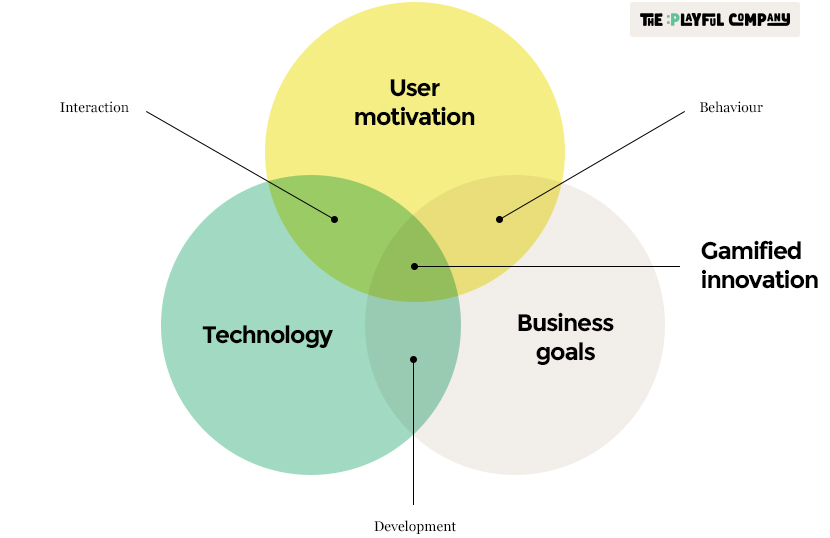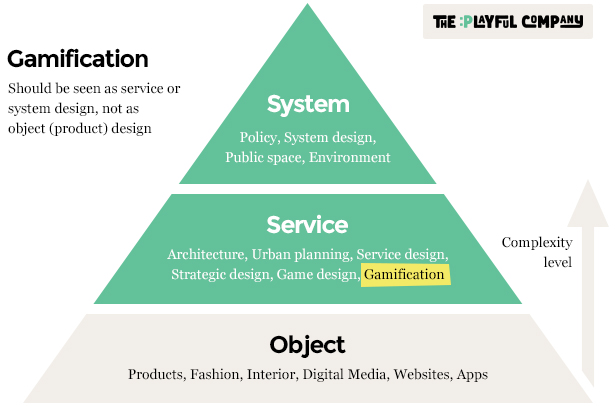When going through any gamification process I use a framework as guidance. It’s a framework I developed in the last years when doing projects with clients. First of all I developed this framework to explain clients about the upcoming process. That gamification ties into the core business objectives. But later on, the framework appeared to have value as well during (kick-off) workshops to get the gamification message across.
“Client input and collaboration are crucial for a successful gamification project.”
As designers, we all have slightly different views on the design process, because of different backgrounds and experience. Because I studied Design Engineering, I believe in a strategic approach towards design. In my opinion most existing frameworks directly go into solutions. Even before setting clear design goals together with the client as a basis for a strategic approach. Client input and collaboration are crucial for a successful gamification project. Some frameworks had this figured out, so my own framework is inspired on these, such as the Delft Design Approach, Design Thinking, Werbach’s 6D framework and others.
Part engineer, part artist
As my study being Design Engineering, I believe (applied) designers are part engineers. Approaching design through a strategic framework to deliver high quality results can partly be engineered. But where Gabe Zichermann at the last Gamification World Congress stated gamification designers should be engineers, I have to disagree.
There are many moments in the gamification design process which can be engineered and approached systematically. But there are also moments which cannot be captured in a framework. These are moments when jumping from abstract ideas to concrete solutions. The moments in which you, as a designer, ‘see’ a game or gamification solution. It is that moment in which you have to take the full spectrum from the discovery phase, together with intel you gathered through experience, knowledge from reading and talking to others and compile this into inspiring ideas.
For me that moment is what distinguish good designers from the really good ones. How fast can you ‘see’ this solution and how good is it going to be?
The framework
The other day I wrote a post on the complexity of gamification design, now it is time to clear things up. What is that framework I am using and how do I apply it for clients and workshops? A quick lesson in Strategic Gamification Design.

Three different design frameworks. No iterations, only internal iterations and both internal and external iterations.
The three frameworks above are slightly different and explain the origin of the design process. The first one being a design process still seeing at many (mostly very big) companies. I’ve had the chance to work at some of these companies and something you’ll notice is their old way of thinking. From a design brief, they analyze, frame, ideate and build and put the product into the market. If it sells it sells, if it doesn’t it doesn’t. And off to the next one. Selling a product is for them the last stop of the process. From that moment there is no contact with the product or user.
The second framework is one proposed in the early days of design thinking and shows us the importance of iterations. During the design process, the design team is performing many iterations to get the product right. They design and quickly test prototypes until it’s ready for launch. The product is shipped to the market.
Where in the previous process, iterations are done in controlled environments by the design team, the third process sees value of iterating in the market itself. More companies see this value of getting products to the market as quickly as possible, which is one of the core beliefs of the lean startup movement. Iterations are done by the design team, but also with actual users.
Closing the loop
Gamification solutions often tend to be digital or have a strong digital component. This has the great advantage of easily connecting with your users. Through your digital product you can connect to users and they can provide crucial feedback in the form of comments, ideas, analytics and behaviour.

The Strategic Gamification Design framework
So this digital connection with users can be used to get feedback and improve your product. But it can also be used to close the loop. Closing the loop means changing the users current version of the product with a newer one. Through these digital channels we can easily push new product updates. While the more analog products out there have different versions in the market, digital products can have only one. The shorter this cycle, the more feedback, the better your product, the better your users.
“The shorter this cycle, the more feedback, the better your product, the better your users.”
Let me explain the different phases in the Strategic Gamification Design framework. There are 7 phases, in which during the phases on the left you mainly ‘Think’ and the ones on the right you ‘Make’.
1. Business Objective
The business objectives are the thriving factor behind any business. They are always about money. Even in organisations, NGO’s or social entrepreneurship, money needs to be made in order to do good. So, business objectives all always about increasing revenue or decreasing cost.
Business objectives always start with: ‘How can we increase revenue / decrease costs by … ?’
2. Discover
In the discover phase all requirements are analyzed needed for the best gamification solution. These are business, market and user requirements.
First of all the challenges are determined. What obstacles stand in between the business objectives and the current situation? Second we do a player analysis. Who are the users or players? What are their primary needs and motivations? Finally we look at the behaviour of theses players. What is their current behaviour that doesn’t work and what is the behaviour they should be doing?
3. Frame
In this phase all information from the previous phase is coming together in one statement: ‘How can you motivate [players] to [target behaviour]?’ This statement is the start for creating gamification solutions.
4. Ideate
This phase holds the difficult transition from abstract thinking to concrete ideas. There are several ideation techniques which can be used such as making comparisons with existing video- or boardgames. In this phase it is crucial to find the loop, to find that core activity which can make players progress on the long-term.
5. Build
Quickly build ideas into rapid prototypes to test them with possible users. Use paper prototype techniques for not losing too much time building real ones. Do iterations if prototypes don’t seem to work.
6. Use
This is the first phase your products enters the real world. After the building phase, put your best (but also most simple) product in the market and let users interact with your product in the real setting. Listen to your users and gather feedback.
7. Improve
Use feedback to make iterations and improve your product. See if requirements from the discovery phase are still met and if necessary restart ideation.
Progressing from MVP to Alpha
Let’s see how you as a gamification designer can progress through this Strategic Gamification Design framework. When going through this framework and doing a couple of internal iterations, your MVP (Minimal Viable Product) is ready to ship to the market. Improving this MVP through user feedback and going through the full framework again, makes you ready for a Beta release. Some more internal and external iterations delivers your Alpha release.
Going through these loops will progress your solution into a better version, more fit for the market. But it will also improve the client and designer as knowledge and skills are increased. And with this, the principles of gamification design can also be found in the process to get there. As human beings (users, designers, clients) we are getting better at what we do, we are progressing. This is how you should approach any gamification solution. Build better users by building better products.
For me this what gamification design is. Finding those core activity loops and use these to let players progress. Together with clients we search for these broken loops in their products or business and we fix them.





